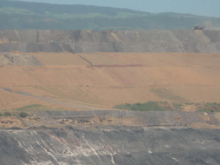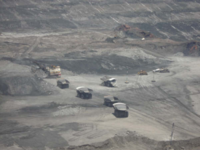- Cerrejón Formation
-
Cerrejón Formation
Stratigraphic range: Middle-Late Paleocene
Section of the Cerrejón coal mine.Type Geological formation Sub-units Lower, Middle, Upper Underlies Tabaco Formation Lithology Primary Sandstone, Mudstone, Siltstone Other Coal Location Region South America Country  Colombia
ColombiaThe Cerrejón Formation is a geologic formation in Colombia dating back to the Middle-Late Paleocene. It is found in the El Cerrejón subbasin of the Racheria basin of La Guajira. The formation consists of bituminous coal fields that are an important economic resource. Coal from the Cerrejón Formation is mined extensively from the Cerrejón open-pit coal mine, one of the largest in the world. The formation also bears fossils that are the earliest record of Neotropical rainforests.[1]
Contents
Geology
The Cerrejón Formation is subdivided into lower, middle, and upper groups based on the thickness and distribution of coal beds. On average the coal beds are 3 metres (9.8 ft) thick, and range from 0.7 metres (2.3 ft) to 10 metres (33 ft) in thickness. The thickest beds are in the upper part of the formation.[2]
Based on lithofacies associations and paleofloral composition, the depositional environment fluctuated from an estuarine-influenced coastal plain at the base of the formation to a fluvial-influenced coastal plain at the top.[3]
In the geologically recent past, some coal in the formation has spontaneously and naturally combusted to form clinker, red and brick-looking burnt coal. These rocks outcrop irregularly and are up to 100 metres (330 ft) thick. Clinker is found near deformed zones such as faults or tight folds, and is older than the deformities themselves. They are thought to have combusted after the development of the Cerrejón thrust fault and alluvial fan.[4]
Paleoenvironment
Fossils found from the Cerrejón Formation are the earliest record of Neotropical rainforests, with an abundance of plant macrofossils and palynomorphs. The Cerrejón Formation also records a riverine vertebrate fauna that includes lungfish, turtles, snakes, and crocodyliforms. Based on these fossils and the stratigraphy of the formation, the Cerrejón Formation was likely formed on a coastal plain covered in a wet tropical rainforest and incised by a large river system.[5]
The rainforest is estimated to have been around 5°N paleolatitude.[1] During the Paleocene, equatorial temperatures were much higher than they are today. Based on the size of the giant boid Titanoboa (specimens of which have been found from the Cerrejón Formation), the mean annual temperature of Paleocene equatorial South America was between 30 °C (86 °F) and 34 °C (93 °F). This is the minimum annual temperature range that a poikilotherm as large as Titanoboa could live.[5] It is consistent with Paleocene climate models which predict greenhouse temperatures and an atmospheric pCO2 concentration of 2,000 parts per million.[6] Paleotemperature estimates based on fossil leaf assemblages from the Cerrejón Formation predict the mean annual temperature to be 6 to 8 °C (43 to 46 °F) lower than other estimates.[7] However, such temperature estimates based on riparian and wetland rainforest paleoflora have been considered underestimates.[8]
Mean annual temperatures of 30 to 34 °C are considered to be too high for modern tropical forests,[9] but the Cerrejón rainforest could have been maintained by increased atmospheric pCO2 levels and the high regional rainfall, which is estimated to have been around 4 metres (13 ft) per year.[3][10][5]
Flora
The floral record of the Cerrejón Formation is well known, with many identifiable and well preserved plant microfossils having been found from the Cerrejón mine. The fossils are well preserved, and in some cases their cell structure is intact.[11] In comparison to modern Neotropical rainforests, the diversity of plants is quite low. This may be an indication of the early stage of Neotropical diversification, or a delayed recovery period following the Cretaceous–Tertiary extinction event.[1]
 Some palms from the formation may belong to the genus Nypa, to which the extant Nypa fruticans also belongs.
Some palms from the formation may belong to the genus Nypa, to which the extant Nypa fruticans also belongs.
Many plants from the Cerrejón Formation belong to families that are still common today in modern Neotropical rainforests. There is a diverse variety of palms and legumes in the formation. In addition to palms and legumes, much of the biomass of the Paleocene forest consisted of laurales, malvales, menisperms, aroids, and zingiberaleans.[1] Studies of fossil plants from Cretaceous-age sites indicate that the floral composition below the K–T boundary was very different from that of the Paleocene. Legumes are absent from Cretaceous strata, and likely appeared or diversified during the Paleocene.[11]
The presence of these types of flora in Paleocene strata shows that plants characteristic of modern Neotropical rainforests have existed for geologically long periods of time, being able to withstand climactic and geographic changes in South America. It has been suggested that today's Neotropical rainforests are the result of environmental changes brought about by Quaternary glacial cycles (i.e. the recent ice age). These cycles would have caused fluctuation in the diversity and extent of rainforests. If this was the case, the current diversity of the Amazon rainforest would be a recent speciation in a changing environment.[12] However, the floral record from the Cerrejón Formation shows that the current diversity of the Amazon Rainforest can be traced back into the early Cenozoic.[1]
Fauna
Feeding damage from insects is evident on some of the plant macrofossils from the Cerrejón Formation. One survey of plant macrofossils showed that around half of the studied specimens had been attacked by herbivorous insects.[1] The insects that damaged the leaves were predominantly generalist feeders, unlike modern Neotropical insects that are mainly specialist herbivores. There is no evidence of the elevated insect-feeding diversity or host-specialized feeding associations that are seen in later Neotropical forests. The insect diversity in the Cerrejón Formation is low in comparison to the diversity of insects in Neotropical rainforests today, and it is likely that leaf damage was made by relatively few species.[1]
Remains of the giant boid Titanoboa cerrejonensis have been found from a gray claystone layer underlying Coal Seam 90 in the Cerrejón mine. Titanoboa is the largest known snake to have ever existed, reaching an estimated length of 13 metres (43 ft). Eunectes, the anaconda, is likely to be a close living analogue of Titanoboa.[5]
A dyrosaurid crocodylomorph called Cerrejonisuchus improcerus was described in 2010 from the Cerrejón Formation in the same layer as Titanoboa. It was a small dyrosaurid, and had the shortest snout length relative to its skull length of any dyrosaurid. Most dyrosaurids were marine, with long snouts adapted for catching fish. The short snout of Cerrejonisuchus is likely to have been an adaptation for a more generalized diet in a transitional aquatic environment.[13] It is possible that Cerrejonisuchus was a food source for Titanoboa, as the two inhabited the same riverine environment.[14] The anaconda has been documented consuming caimans, a feeding habit that is similar to the inferred habit of Titanoboa. A second dyrosaurid, Acherontisuchus, was named in 2011 from the formation. With a large body and long snout, it resembles most other dyrosaurids.[15]
Coal resources
Main article: Cerrejón mineThe Cerrejón Formation contains extensive coal seams that are mined primarily at the Cerrejón mine. The coal is desirable for its low ash and sulfur content and for its resistance to caking. Cerrejón is Colombia's largest coal producing mine, with most of the production exported to Europe. It is the largest coal mining operation in Latin America, with an estimated 28.4 million tons mined in 2006.[2][16]
References
- ^ a b c d e f g Wing, S. L.; Herrera, F.; Jaramillo, C. A.; Gómez-Navarro, C.; Wilf, P.; and Labandeira, C. C. (2009). "Late Paleocene fossils from the Cerrejón Formation, Colombia, are the earliest record of Neotropical rainforest". Proceedings of the National Academy of Sciences Forthcoming (44): 18627. doi:10.1073/pnas.0905130106. http://www.pnas.org/content/early/2009/10/14/0905130106.full.pdf+html.
- ^ a b Tewalt, S. J.; Finkelman, R. B.; Torres, I. E.; and Simoni, F. (2006). "World Coal Quality Inventory: Colombia". In Alex W. Karlsen, Susan J. Tewalt, Linda J. Bragg, and Robert B. Finkelman (eds.). World Coal Quality Inventory: South America. U.S. Geological Survey Open File Report 2006. United States Geological Survey. pp. 132–157. http://pubs.usgs.gov/of/2006/1241/.
- ^ a b Jaramillo, C. A.; Pardo-Trujillo, A.; Rueda, M.; Torres, V.; Harrington, G. J.; and Mora, G. (2007). "The palynology of the Cerrejon Formation (upper Paleocene) of northern Colombia". Palynology 31: 153–189. doi:10.2113/gspalynol.31.1.153.
- ^ Quintero, J. A.; Candela, S. A.; Rios, C. A.; Montes, C.; and Uribe, C. (2009). "Spontaneous combustion of the Upper Paleocene Cerrejón Formation coal and generation of clinker in La Guajira Peninsula (Caribbean Region of Colombia)". International Journal of Coal Geology 80 (3): 196–210. doi:10.1016/j.coal.2009.09.004.
- ^ a b c d Head, J. J.; Bloch, J. I.; Hastings, A. K.; Bourque, J. R.; Cadena, E. A.; Herrera, F. A.; Polly, P. D.; and Jaramillo, C. A. (2009). "Giant boid snake from the Palaeocene neotropics reveals hotter past equatorial temperatures". Nature 457 (7230): 715–717. doi:10.1038/nature07671. PMID 19194448. http://mkatti-classes.pbworks.com/f/Head_etal_GiantBoidSnake_Nature2009.pdf.
- ^ Shellito, C. J.; Sloan, L. C.; and Huber, M. (2003). "Climate model sensitivity to atmospheric CO2 levels in the Early–Middle Paleogene". Palaeogeography, Palaeoclimatology, Palaeoecology 193: 113–123. doi:10.1016/S0031-0182(02)00718-6.
- ^ Herrera, F.; Jaramillo, C.; and Wing, S. L. (2005). "Warm (not hot) tropics during the Late Paleocene: First continental evidence". Proceedings of American Geophysical Union Fall Meeting, San Francisco, California, USA. 86. Washington, D.C. USA: American Geophysical Union. pp. 51C–0608. http://adsabs.harvard.edu/abs/2005AGUFMPP51C0608H.
- ^ Kowalski, E. A.; and Dilcher, D. L. (2003). "Warmer paleotemperatures for terrestrial ecosystems". Proceedings of the National Academy of Sciences 100: 167–170. doi:10.1073/pnas.232693599.
- ^ Burnham, R. J.; and Johnson, K. R. (2004). "South American palaeobotany and the origins of neotropical rainforests". Philosophical Transactions of the Royal Society of London B 359 (1450): 1595–1610. doi:10.1098/rstb.2004.1531. PMC 1693437. PMID 15519975. http://www.pubmedcentral.nih.gov/articlerender.fcgi?tool=pmcentrez&artid=1693437.
- ^ Hogan, K. P.; Smith, A. P.; and Ziska, L. H. (1991). "Potential effects of elevated CO2 and changes in temperature on tropical plants". Plant, Cell & Environment 14 (8): 763–778. doi:10.1111/j.1365-3040.1991.tb01441.x.
- ^ a b Kanapaux, B. (October, 2009). "Plant fossils give first real picture of earliest Neotropical rainforests". Science Stories: Florida Museum of Natural History. http://www.flmnh.ufl.edu/sciencestories/2009/neotropical_rainforest.htm. Retrieved February 14, 2010.
- ^ Richardson, J. E.; Pennington, R. T.; Pennington, T. D.; and Hollingsworth, P. M. (2001). "Rapid diversification of a species-rich genus of Neotropical rain forest trees". Science 293 (5538): 2242–2245. doi:10.1126/science.1061421. PMID 11567135.
- ^ Hastings, A. K; Bloch, J. I.; Cadena, E. A.; and Jaramillo, C. A. (2010). "A new small short-snouted dyrosaurid (Crocodylomorpha, Mesoeucrocodylia) from the Paleocene of northeastern Colombia". Journal of Vertebrate Paleontology 30 (1): 139–162. doi:10.1080/02724630903409204.
- ^ Kanapaux, B. (February 2, 2010). "UF researchers: Ancient crocodile relative likely food source for Titanoboa". University of Florida News. http://news.ufl.edu/2010/02/02/titanoboa-food/. Retrieved February 3, 2010.
- ^ Hastings, A.K.; Bloch, J.I. and Jaramillo, C.A. (2011). "A new longirostrine dyrosaurid (Crocodylomorpha, Mesoeucrocodylia) from the Paleocene of north-eastern Colombia: biogeographic and behavioural implications for new-world dyrosauridae". Paleontology 54 (5): 1095–1116. doi:10.1111/j.1475-4983.2011.01092.x. http://www.stri.si.edu/sites/publications/PDFs/STRI-W_Jaramillo_2011_Hasting_croc_Cerrejon.pdf. Retrieved 14 Sep 2011.
- ^ "El Cerrejón Coal Mine, Colombia". Mining-technology.com. Net Resources International. http://www.mining-technology.com/projects/cerrejon/. Retrieved February 7, 2010.
Categories:- Geology of Colombia
- Mining in Colombia
- Natural history of Colombia
Wikimedia Foundation. 2010.


